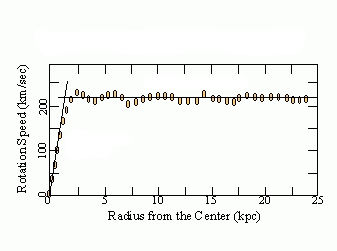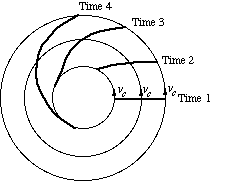The Mass of our Galaxy
We can use this information, the speed at which we are rotating,
to tell us how much mass we are trying to hold up against. The
faster we go, then there must be more mass interior to our orbit
(or we'd be leaving the Galaxy). We are about 8.5 kiloparsecs
from the Center of our Galaxy (this is almost 30,000 light years
).
The Sun formed about 5 billion years ago. It takes only 240 Million years to go around the Galaxy, so we've already been around the Galaxy 20 times---safe to assume we're in a stable orbit. We can derive the speed of stars at all different radii and determine a Rotation Curve for the Galaxy:

|

|
We find that the speed of rotation stays constant as you go further out in the galaxy. This is called differential rotation, as opposed to solid body rotation. If you were to mark a line connecting the stars out from the center of the Galaxy and wait a while, it will spiral up! (see diagram upper right).
Strangely, at large radii, far from the galactic center, we see evidence of significant mass, beyond where we see any visible stars. This is called dark matter, material which has mass, but which does not produce any detectable light. Some of this dark matter may also lie within the disk, interspersed with the normal stars and interstellar medium. But, it appears to dominate the mass of the halo and outer galaxy.
Astronomers have estimated the mass of the Milky Way Galaxy to be: